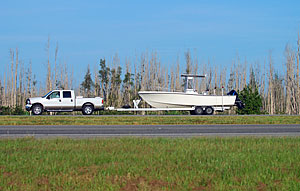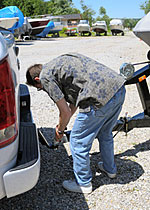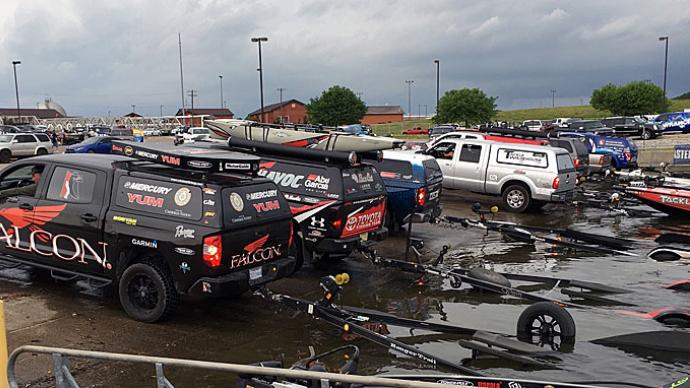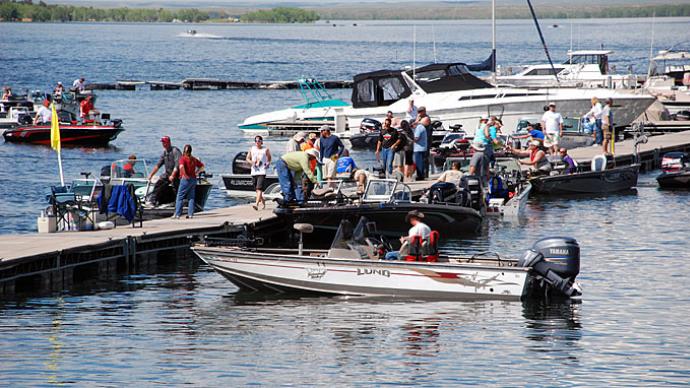
Buying a recreational boat is an exciting experience, and to make sure you have fun on the water it’s imperative to get your boat out of the water safely. Loading and towing a boat requires careful planning and special driving techniques. Follow these best practices for loading and towing and you’ll be ready for the road.
Tow Vehicle Selection
The weight of your boat is a main factor in determining what kind of tow vehicle to use. SUVs and trucks are popular for towing, much better choices than cars, the heaviest of which have trouble towing loads in the vicinity of 2,000 pounds. Towing capacities of SUVs and trucks vary depending on engine size, horsepower, gearing and other factors. Generally, a light-duty pickup truck or SUV is a good choice for loads in the 2,000-pound to 4,000-pound range, whereas full-size trucks and some SUVs can handle loads in excess of 8,000 pounds to 12,000 pounds with ease.
The important thing is to check tow capacity specifications of the vehicle you are considering, and remember it is better to be safe than sorry; if your load approaches the maximum capacity of the tow vehicle, consider stepping up to a higher rated vehicle.
In addition to tow capacity, a suitable vehicle for boat towing should have other important features, in particular oversized mirrors, a heavy-duty cooling system (especially important if you will be towing uphill), heavy-duty suspension, specially designed downhill braking systems, and trailer wiring. Most vehicles used for towing have special tow packages available.
Trailer Selection
Roller trailers are primarily used for loading and unloading a boat in shallow water. Bunk trailers, which are less expensive, are more efficient for deeper water. If you plan to use your boat in both shallow and deep water, consider a combination design, which gives you maximum versatility.

Galvanized steel is a common trailer material, because it is extremely strong and rust resistant. However, over time, even galvanized steel can corrode, especially in harsh environments. Aluminum construction makes for a more lightweight trailer, and is does not rust. Aluminum trailers, like steel, can still decay over time depending on conditions, use and care. The weight of your boat is a major factor in determining whether steel or aluminum is the right choice. For boats less than 5,000 pounds to 6,000 pounds, aluminum should work fine; heavier boats usually require the heft of a steel trailer.
Disc brakes with “surge” systems are the most common design for boat trailers, proven over time to be a reliable choice. Electro-over-hydraulic braking systems, often used for campers, are another option.
In addition to bunk versus roller, the material and braking systems, consider the thickness and quality of the steel or aluminum, as well as details, such as whether hardware has stainless steel construction. Water, especially saltwater, is corrosive and a trailer with non-durable components will require a lot of maintenance and repair.
Hitch Selection
Trailer hitches come in five basic classes:
- Class I is rated up to 2,000 pounds gross trailer weight (GTW)
- Class II — 3,500 pounds GTW
- Class III — 5,000 pounds GTW
- Class IV — 7,500 pounds GTW
- Class V — 10,000 pounds GTW
Obviously, the weight of your boat and trailer will determine the class of hitch needed. Class III hitches are widely used for boat towing; they are heavy duty to begin with, and when used in conjunction with a weight distribution system, can increase capacity, to over 12,000 pounds, depending on the system. Trailer hitches may be the smallest component of your boat towing system, but it holds everything together. Select a hitch made from high-quality, corrosion-resistant materials, and that has been thoroughly tested and proven over time. Hitches come in a wide variety of models to accommodate easy mounting on various types and models of tow vehicles. In addition to the hitch, you will need to consider the trailer ball and ball mount separately. It is important that all three components — hitch, ball and ball mount — are the same size and have the same capacity rating; otherwise, the trailer weight capacity will revert to the lowest of the three ratings.
Launching/Loading
Before you back into the boat ramp, park and move any gear from the tow vehicle to the boat. Uncover the boat, and remove tie-down, and then put the key in the ignition and put the plug in the boat. With a bunk-style trailer, the winch strap can be unhooked at this point. For roller trailers, the winch strap is unhooked after the boat is in the water.

Now the trailer can be backed into the ramp and moved slowly into the water, unhooking the winch strap if necessary. While you are in the tow vehicle, another person will be in the boat, to run the blower, set the kill switch to run, and start the motor. At this point, the person in the boat can release the bow hooks from the trailer, and you can pull the tow vehicle away from the ramp. For loading, the process is reversed. Keep in mind this is a two-person job, so it may be helpful to visit the launch area beforehand to see how other, more experienced, boaters handle the launching and loading processes. You will no doubt observe that there is a lot of communication, and launching and loading proceed slowly, carefully and methodically.
Driving
You will quickly learn that towing a boat considerably changes the driving experience. Because of the additional weight, you will need to slow down: drive at a lower speed, brake more slowly, turn more slowly, and accelerate more slowly. The tow vehicle will require more time to brake, so leave a lot of extra space between yourself and the vehicle in front of you. Tail gaiting is out of the question!
To practice turns, backing up and parking, find a place with plenty of room to maneuver, such as an empty parking lot. In particular, turning usually takes a good deal of practice to find the right angle so that you don’t overshoot or undershoot the turn. Also, similarly to when you first learned to drive, you will find it helpful to have someone with boat towing experience accompany you, someone who can point out the tricks of the trade and give you insight on how to handle local road and driving conditions.
Before you begin driving, make sure your trailer is properly connected to the hitch, and that all brake lights and turn signals are functioning. Also, make sure tires are fully and evenly inflated. When you are on the road, check the hitch, wiring and straps to make sure they are still secure — road vibration can loosen them.
For all aspects of boat loading and towing, it pays to do your research, handle all aspects of the work with safety in mind, and seek the assistance of experienced boaters. If you run into problems on the road or the launch site, don’t be too quick to improvise, and by all means don’t panic. There’s a good chance you can find help from someone nearby or online, because whatever happened to you has probably happened to a lot of other people as well. Stick with it, and you’ll begin to feel very comfortable after your first few trips.
Tim Heinen is an eCommerce Content Specialist at CURT Manufacturing, LLC. CURT is a manufacturer, importer, and distributor of towing system products.




